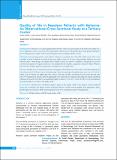Please use this identifier to cite or link to this item:
https://hdl.handle.net/20.500.14356/884Full metadata record
| DC Field | Value | Language |
|---|---|---|
| dc.contributor.author | Paudel, Sushil | - |
| dc.contributor.author | Poudel, Indu Acharya | - |
| dc.contributor.author | Upadhyay, Priti | - |
| dc.contributor.author | Shah, Manish Kumar | - |
| dc.contributor.author | Pokharel, Shruti | - |
| dc.contributor.author | Sharma, Rabindra | - |
| dc.date.accessioned | 2023-04-03T07:55:10Z | - |
| dc.date.available | 2023-04-03T07:55:10Z | - |
| dc.date.issued | 2022 | - |
| dc.identifier.citation | PaudelS., Acharya PoudelI., UpadhyayP., Kumar ShahM., PokharelS., & SharmaR. (2022). Quality of life in Nepalese Patients with Melasma: An Observational Cross-Sectional Study at a Tertiary Center. Journal of Nepal Health Research Council, 20(02), 316-320. https://doi.org/10.33314/jnhrc.v20i02.3875 | en_US |
| dc.identifier.issn | Print ISSN: 1727-5482; Online ISSN: 1999-6217 | - |
| dc.identifier.uri | http://103.69.126.140:8080/handle/20.500.14356/884 | - |
| dc.description.abstract | Abstract Background: Melasma is an acquired pigmentation disorder of the sun exposed parts of the body, particularly face. It is a significant cosmetic concern for the young adults, which is the most frequently affected age-group. Finding the level of impairment in quality of life in melasma patients and correlating with the severity. Methods: All consenting patients with melasma visiting our out-patient from December 2020 to June 2021 were enrolled. Clinical evaluation was done by the same single reviewer in all cases using modified Melasma Area and Severity Index. Dermatology Life Quality Index (Nepali version) was asked to complete to the patient. Data were collected and analyzed. Frequency and mean were calculated for all variables, comparison of means by Mann-Whitney U test and correlation analyses by Spearman’s correlation test were performed. Results: Females were 82.5%(99) of total cases. Among these 70.8%(85) were married, 68.3%(82) had family history of melasma and 65%(78) had centro-facial phenotype. Mean Dermatology Life Quality Index score was 10.25±0.54. Mean score of females was higher than that of males. The daily activities sub-domain was the worst affected with 50.67% of impairment. Females suffered significantly more than males in symptom and feeling sub-domain. Modified Melasma Area and Severity Index was significantly higher in males (7.12±.56 Vs. 5.66±.28). The severity and duration of melasma did not correlate to the quality of life. Conclusions: Melasma had a moderately negative impact in the quality of life of the patients. Females suffered more due to melasma. The clinical severity of melasma did not correlate with the quality of life impairment. Thus, psychological assessment to all the melasma patients seem to be an important aspect of management. Keywords: DLQI; melisma; mMASI; Nepal; quality of life | en_US |
| dc.language.iso | en | en_US |
| dc.publisher | Nepal Health Research Council | en_US |
| dc.relation.ispartofseries | April-June, 2022; | - |
| dc.subject | DLQI | en_US |
| dc.subject | Melisma | en_US |
| dc.subject | mMASI | en_US |
| dc.subject | Nepal | en_US |
| dc.subject | Quality of life | en_US |
| dc.title | Quality of life in Nepalese Patients with Melasma: An Observational Cross-Sectional Study at a Tertiary Center | en_US |
| dc.type | Journal Article | en_US |
| Appears in Collections: | Vol 20 No 02 Issue 55 April-June, 2022 | |
Files in This Item:
| File | Description | Size | Format | |
|---|---|---|---|---|
| 3875-Manuscript-29673-2-10-20221103.pdf | Full Article. | 207.53 kB | Adobe PDF |  View/Open |
Items in DSpace are protected by copyright, with all rights reserved, unless otherwise indicated.
